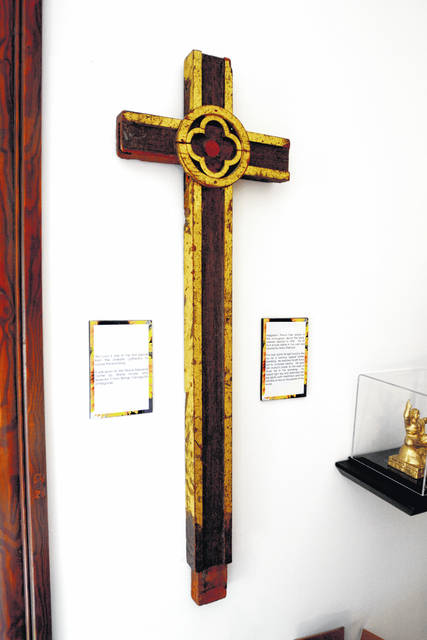
WILMINGTON — Wilmington College’s Peace Resource Center is returning a wooden cross that was recovered from the ruins of the Urakami Cathedral destroyed in the 1945 atomic-bombing of Nagasaki.
Dr. Tanya Maus, director of the Peace Resource Center (PRC), said she plans to bring the artifact to Japan later this summer as an “international goodwill gesture of peace and reconciliation.”
The cross has been part of the PRC’s display of items related to the atomic-bombings of Hiroshima and Nagasaki since it was given to the Center in 1982.
“As an artifact that embodies the sufferings of those Urakami parishioners who died in the atomic bombings, it is held sacred by those of the Urakami Cathedral — and should be returned,” she said.
Maus noted how visitors to the PRC from Nagasaki in recent years were especially “moved” when hearing about the origins of the cross. “I thought it would be better to have it returned to Nagasaki — (WC President Jim Reynolds) agreed this is the right thing to do,” she added.
Maus shared her knowledge of what will be a 74-year journey of the meter-long wooden cross with gold-colored trim culminating with its presentation at the rebuilt Urakami Cathedral.
U.S. Marine Walter Hooke apparently retrieved the cross from the rubble of the Catholic cathedral, with permission from the bishop of Nagasaki, he claimed, and sent it to his mother in the United States. A Catholic, he was stationed in Nagasaki shortly following the Aug. 9, 1945 atomic-bombing.
Many in the United States believe that the nuclear bombings hastened the end of World War II while, within several months, as many as 226,000 mostly civilians in the two Japanese cities perished.
Maus noted that Hooke, who died at age 97 in 2010, became publicly critical of the A-Bomb’s use on civilian populations in Japan and, as a member of the Atomic Veterans’ Assn., advocated for compensating U.S. military personnel who were exposed to radiation, during both the testing and deployment of nuclear weapons.
During those protest activities, Hooke’s path crossed with that of Barbara Reynolds, a staunch, anti-nuclear weapons activist and the founding director of the Peace Resource Center, who had many connections to the victims of Hiroshima and Nagasaki.
Hooke gave the cross to the PRC in 1982.
Maus, who’s been director since 2015, said a serendipitous series of events led to her plans to return the cross. This spring, she attended a Japan-related conference at which she learned of Dr. Hirokazu Miyazaki, an anthropologist at Northwestern University who is known as a “peace correspondent” for Nagasaki.
Miyazaki is writing a book about the 1927 Doll Exchange, an initiative led by the American United Church of Christ in which more than 11,000 dolls were given to children in Japan nearly a century ago. Wilmington area Quakers contributed seven of the dolls.
This year, the College’s campus minister, Nancy McCormick, led the making of 100 Quaker-style rag dolls that she and Maus will present in Nagasaki and Hirado, Japan, as another international gesture of goodwill. They also will meet with WC students Emma Marks and Julio Olivarez, who are engaged in summer internships in sustainable farming at Asia Rural Institute in Tochigi, Japan.
Miyazaki was excited to learn of this modern version of the doll exchange and visited Wilmington this spring to interview the women making dolls. Maus subsequently learned he has ties to the Catholic community and cathedral in Nagasaki.
“He reached out to the archbishop in Nagasaki, Mitsuaki Takami, who didn’t know the cross existed here,” Maus said, noting that Asahi journalists located a photograph of the cross lying in the ruins of the cathedral taken in August 1945. She said a Japanese news organization has reported the Nagasaki Peace Assoc. had been trying to locate the Christian symbol for 30 years.
“Very few artifacts from the cathedral were retained and that’s why it’s crucial to give back that cross, which is so deeply tied to their identity,” Maus said.
Takami welcomed Maus’ offer to return the cross Aug. 7 while she is in Nagasaki attending the Atomic Bomb Victims’ Memorial Peace Prayer Ceremony Aug. 9. It will be displayed at the rebuilt Urakami Cathedral.
“This is something we need to do,” Maus said. “These are connections that help build a more peaceful world.”
The Peace Resource Center at Wilmington College works for peace by bearing witness to the historical experience of Hiroshima and Nagasaki atomic bombing survivors and the legacies of nonviolent activists touched by the horrors of nuclear war. The four core commitments that inform the work of the Center are: commitments to nonviolence, disarmament, peace inquiry and consciousness, and just peace.


